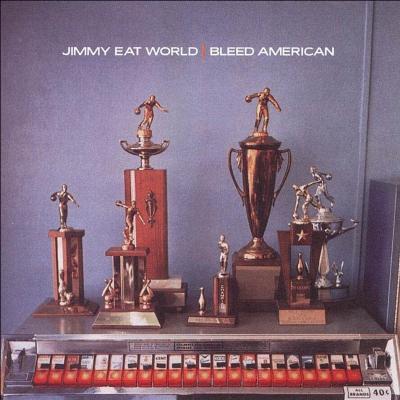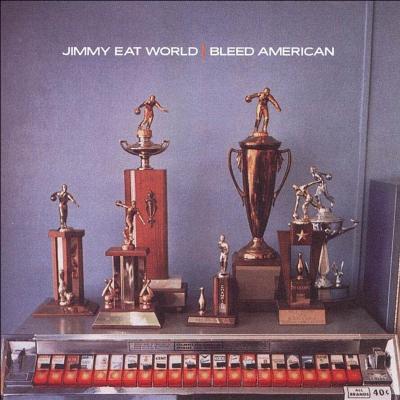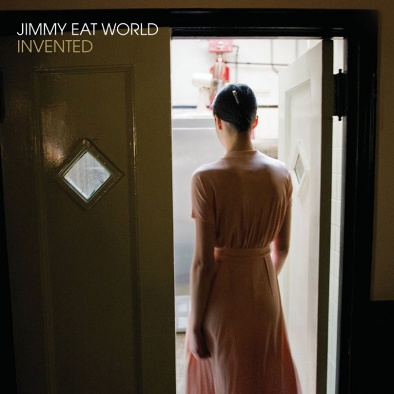As we discussed yesterday on Unframed, the current William Eggleston exhibition includes the many album covers which feature Eggleston’s photographs. Among them is Jimmy Eat World’s Bleed American, released in 2001, which uses an untitled photo from Eggleston’s Los Alamos series. I got in touch with Jimmy Eat World’s singer/guitarist, Jim Adkins, to ask him about the image and how photography impacts their music.
In general, how does your band decide what images to use for your album covers? What is the process for creating album art? Specifically, how was Eggleston’s untitled work from the Los Alamos series chosen?
We have a consensus on the general mood we want to present. Then, we search out how to achieve it. Everyone pitches in ideas. Usually there are a handful that we explore in depth. We use an outside art director to do the work for delivery to the label. Occasionally they will throw in an idea that sends us back thinking about it all again. It is not unlike recording music in a band/producer environment. Because we just got a new record deal with a label who seemed to be MUCH more behind what we were doing, Bleed American was the first time we thought we could get away with something more ambitious—as in using someone prominent for imagery. The worst they’d say was no, right?
What drew you to that image? Was there something about it that you felt connected to the album’s title or themes, or the band’s state of mind at the time?
For me and for us as a group it has always been about balancing pride and perspective. You can be smart about opportunities that may come your way, but your work is the only thing you can really control. Making something you feel is your best work is your only guaranteed success. You absolutely have to feel that way about your work or you aren’t done. You aren’t ready to present that work to everyone else. In Eggleston’s image there’s no reason at all for you to be impressed with whatever achievements those trophies represent. Just like any commercial success you achieve is fragile. You are very lucky if a listener can make a connection to your work. It’s something you should never take for granted.
You studied photography in school, prior to going full-time with Jimmy Eat World, correct? Who are some of your favorite photographers, or favorite photographs?
Yeah. I was on the road to some kind of photography-based career before the devil music got to me. Eugene Richards always blew me away. Seeing his work made me want to do photojournalism. Some others would be: Anna Gaskell, Andreas Gursky, the Ray’s a Laugh stuff from Richard Billingham, Nan Goldin, Alec Soth, Christopher Wray-McCann... tons more!
I was reading about your latest album, Invented, and it sounds like photography was a big influence on the songwriting of that record. Was this the first time that photographic imagery has impacted your songwriting, or do you often think in images when you write?
Just purely as an exercise to get my brain in a writing mode, I would take 10–15 minutes and free write based on Cindy Sherman and Hannah Starkey images. It was an extension of another exercise called object writing where you take a random noun and do the same thing trying to incorporate all senses. The point really wasn’t to get song ideas, but later in the day I found some of the more interesting ideas were creeping into the music I was working on. Probably 85–90% of Invented has photographic works by those two as a jumping off point. The art for Invented, by the photographer Ken Schles, is kind of a loose full circle, with the images representing scenes from the songs.
Eggleston’s photos have graced a lot of great albums over the years—Big Star’s Radio City, Alex Chilton’s Like Flies on Sherbert, and Primal Scream’s Give Out but Don’t Give Up are some of the big ones. The photo from Chilton’s solo album even comes from the same series as the photo on Bleed American. Were you conscious of these albums’ covers when you chose the image for Bleed American, and/or was it meaningful to you that your album would have that in common with them?
I had no idea at the time.
Since Bleed American’s release in 2001, a lot more bands have used Eggleston’s photos for their album covers, including Chuck Prophet (who is performing at LACMA next week), Joanna Newsome, and most recently Spoon. What do you think it is about Eggleston that draws so many rock bands?
I think so much of a cover is just trying to get the overall mood right. It’s not always easy to articulate. Maybe people just find the composition and tone of his work to say what they can’t about their music work.





